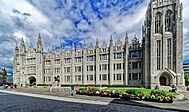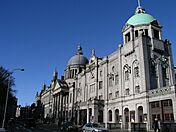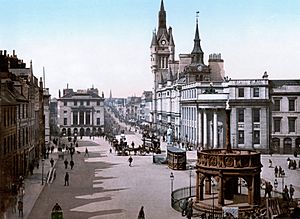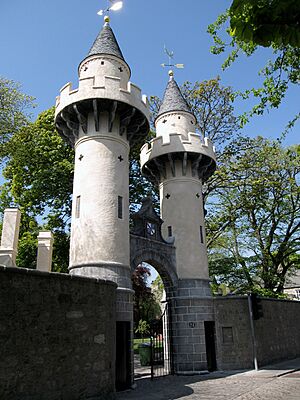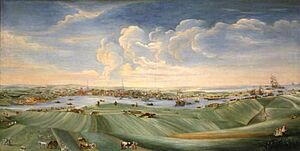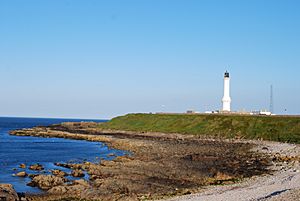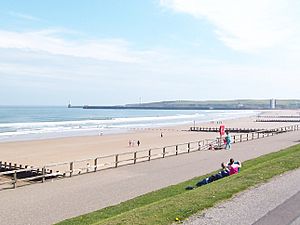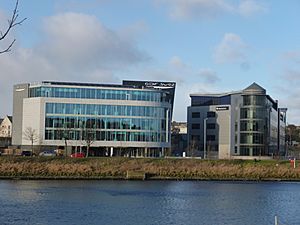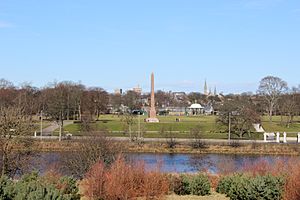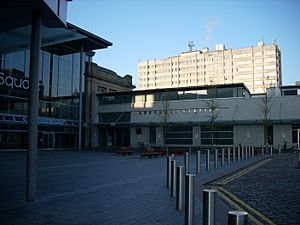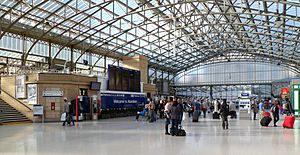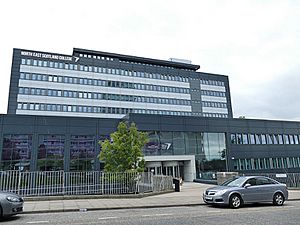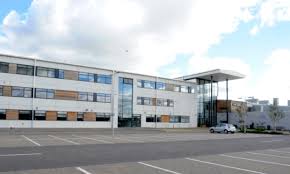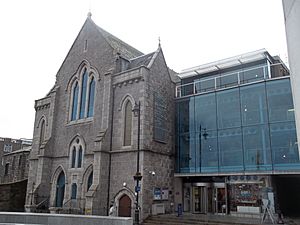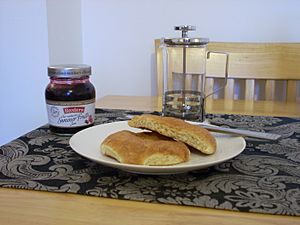Aberdeen facts for kids
Quick facts for kids
Aberdeen
|
|||
|---|---|---|---|
|
City, lieutenancy and council area
|
|||
|
|
|||
|
|||
| Nickname(s):
Granite City, the Silver City by Sea, Oil Capital of Europe
|
|||
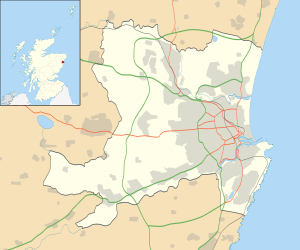
Aberdeen shown within Scotland
|
|||
| Sovereign state | United Kingdom | ||
| Country | Scotland | ||
| Earliest Charter | 1179 | ||
| City status | 1891 | ||
| Unitary authority | 1 April 1996 | ||
| Administrative HQ | Town House | ||
| Government | |||
| • Type | Council | ||
| • Body | Aberdeen City Council | ||
| Area | |||
| • Total | 72 sq mi (186 km2) | ||
| Area rank | 25th | ||
| Population
(2022)
|
|||
| • Total | 224,190 | ||
| • Rank | 8th | ||
| • Density | 3,130/sq mi (1,208/km2) | ||
| Demonym(s) | Aberdonian | ||
| Time zone | UTC+0 (GMT) | ||
| • Summer (DST) | UTC+1 (BST) | ||
| Postcode areas |
AB10–13 (part), AB14–16, AB21–25
|
||
| Dialling codes | 01224 | ||
| ISO 3166 code | GB-ABE | ||
| GSS code | S12000033 | ||
Aberdeen (![]() i/ˌæbərˈdiːn/ ab-ƏR-deen) is a city in North East Scotland. It is the third largest city in Scotland by population. Aberdeen is also known as the "Granite City" or the "Silver City by the Sea" because many of its buildings are made from sparkling grey granite. Since oil was found in the North Sea in 1969, Aberdeen has also been called the "Oil Capital of Europe".
i/ˌæbərˈdiːn/ ab-ƏR-deen) is a city in North East Scotland. It is the third largest city in Scotland by population. Aberdeen is also known as the "Granite City" or the "Silver City by the Sea" because many of its buildings are made from sparkling grey granite. Since oil was found in the North Sea in 1969, Aberdeen has also been called the "Oil Capital of Europe".
People have lived in the Aberdeen area for at least 6,000 years. The city received its first special permission, called a royal burgh status, from King David I of Scotland between 1124 and 1153. This helped the city's economy grow. Today, traditional jobs like fishing and paper-making have been mostly replaced by the oil industry.
Aberdeen has a very busy heliport (for helicopters) and a large seaport. It is also a university town, home to the University of Aberdeen, which was founded in 1495. This makes it one of the oldest universities in the English-speaking world. In 2012, Aberdeen was named one of the UK's top "super cities" for business.
Contents
- Exploring Aberdeen's Past: A Journey Through History
- How Aberdeen is Governed and Its Symbols
- Aberdeen's Natural Surroundings
- Who Lives in Aberdeen?
- Aberdeen's Economy: From Granite to Oil
- Famous Places and Green Spaces
- Getting Around Aberdeen
- Learning in Aberdeen
- Aberdeen's Culture and Fun
- Public Services in Aberdeen
- Sports in Aberdeen
- Aberdeen's Twin Cities
- Famous People from Aberdeen
- Images for kids
- See also
Exploring Aberdeen's Past: A Journey Through History
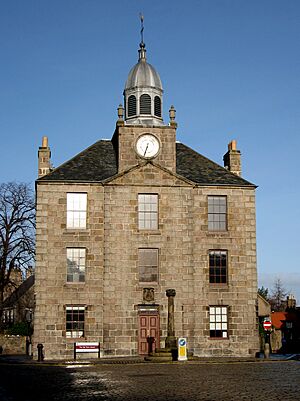
People have lived in the Aberdeen area for at least 8,000 years. The city actually started as two separate towns: Old Aberdeen by the River Don, and New Aberdeen, which was a fishing and trading village by the River Dee.
In 1179, King William the Lion gave Aberdeen its first special permission, called a charter. This allowed the town to have its own rights. Later, in 1319, King Robert the Bruce gave Aberdeen a "Great Charter." This made the city financially independent and gave it land, like the nearby Forest of Stocket. The money from this land still helps the people of Aberdeen today.
During the Wars of Scottish Independence, Aberdeen was controlled by the English. But in 1308, Robert the Bruce attacked and destroyed Aberdeen Castle, taking the city back for the Scottish people. In 1336, the city was burned by Edward III of England, but it was quickly rebuilt and became known as New Aberdeen. The city used to have strong walls and gates to protect it, but these were removed by 1770.
Between 1644 and 1647, during a period of wars in Scotland, the city was attacked and robbed by both sides. In 1647, a terrible disease called the bubonic plague hit Aberdeen, killing a quarter of its population.
In the 1700s, Aberdeen started to grow and improve. A new Town Hall was built, and the city began offering social services. The first hospital, the Aberdeen Royal Infirmary, opened in 1742. At the end of the 1700s, major roads like George Street, King Street, and Union Street were built, making travel easier.
Building these expensive roads caused the city to go bankrupt in 1817, after the Napoleonic Wars. However, Aberdeen soon recovered. The city's port became more important, especially with the growth of shipbuilding and fishing. This led to the building of the current harbour. Gas street lighting came in 1824, and a better water supply in 1830. In 1865, an underground sewer system was built to replace the old open sewers. In 1891, Aberdeen officially became a city, and nearby towns like Old Aberdeen and Torry became part of it.
What's in a Name? The Meaning of Aberdeen
The name Aberdeen means "mouth of the river Don." The word aber comes from an old Celtic language and means "river mouth." The second part of the name comes from an ancient Celtic river goddess named Devona.
How Aberdeen is Governed and Its Symbols
How the City is Run
The first town of Aberdeen was created by King David I of Scotland between 1124 and 1153. Later, Old Aberdeen to the north became its own separate town in 1489.
Aberdeen was governed by a town council. As the city grew, the council's powers needed to expand. In 1891, the city's borders grew much larger, taking in Old Aberdeen, Woodside, and Torry. This act of parliament also officially confirmed that Aberdeen could be called a city.
Today, Aberdeen is a council area in Scotland, meaning it has its own local government, the Aberdeen City Council.
City Symbols: Coat of Arms and Motto
The city's coat of arms and flag show three silver towers on a red background. This design is very old, dating back to the time of Robert the Bruce. It represents the buildings that once stood on the three hills of medieval Aberdeen.
Aberdeen's motto is "Bon Accord," which is French for "Good Agreement." Legend says this was a secret password used by Robert the Bruce when he attacked Aberdeen Castle in 1308. You can still see "Bon Accord" all over the city, in street names and even a shopping mall.
The city's shield is held up by two leopards. These leopards are so famous that small statues of them were placed on the Union Bridge, and people call them "Kelly's Cats." The city's special toast is "Happy to meet, sorry to part, happy to meet again."
Aberdeen's Natural Surroundings
Aberdeen is located between the mouths of two rivers, the River Dee and the River Don. The city's buildings are often made from granite, a strong rock that was quarried nearby. This granite can sparkle like silver because it contains a mineral called mica.
Along the coast, Aberdeen has a long, sandy beach between the two rivers. North of the River Don, the beach turns into tall sand dunes. South of the River Dee, you'll find steep, rocky cliffs with small pebble beaches in hidden coves.
The city covers about 185.7 sq mi (481 km2). It includes areas that used to be separate towns, like Old Aberdeen and Torry. Aberdeen is built on several hills, with the first parts of the city growing around Castle Hill, St. Catherine's Hill, and Windmill Hill.
Aberdeen's Weather
Aberdeen has an oceanic climate, which means it has cool summers and mild, rainy winters. Even though it's quite far north, the winters are not as cold as you might expect.
In winter, especially December, the days are very short, with only about 6.5 hours of daylight. But as winter ends, the days get longer quickly. In summer, around June, the days are very long, with almost 18 hours of daylight. During this time, the sky never gets completely dark at night.
Summer temperatures are usually around 17.0 °C (62.6 °F) during the day. The North Sea helps keep the coast a bit cooler. It can also be quite cloudy in summer compared to spring.
| Climate data for Aberdeen Dyce 65m asl, 1981–2010, extremes 1960– | |||||||||||||
|---|---|---|---|---|---|---|---|---|---|---|---|---|---|
| Month | Jan | Feb | Mar | Apr | May | Jun | Jul | Aug | Sep | Oct | Nov | Dec | Year |
| Record high °C (°F) | 17.2 (63.0) |
17.2 (63.0) |
21.6 (70.9) |
23.7 (74.7) |
24.3 (75.7) |
26.7 (80.1) |
29.8 (85.6) |
29.7 (85.5) |
25.9 (78.6) |
22.0 (71.6) |
18.8 (65.8) |
15.7 (60.3) |
29.8 (85.6) |
| Mean daily maximum °C (°F) | 6.5 (43.7) |
6.8 (44.2) |
8.8 (47.8) |
10.9 (51.6) |
13.6 (56.5) |
16.1 (61.0) |
18.5 (65.3) |
18.3 (64.9) |
15.8 (60.4) |
12.4 (54.3) |
8.9 (48.0) |
6.6 (43.9) |
12.0 (53.6) |
| Mean daily minimum °C (°F) | 0.6 (33.1) |
0.8 (33.4) |
1.9 (35.4) |
3.4 (38.1) |
5.7 (42.3) |
8.6 (47.5) |
10.8 (51.4) |
10.5 (50.9) |
8.6 (47.5) |
5.9 (42.6) |
2.9 (37.2) |
0.7 (33.3) |
5.1 (41.2) |
| Record low °C (°F) | −19.3 (−2.7) |
−18.2 (−0.8) |
−15.8 (3.6) |
−6.8 (19.8) |
−4.2 (24.4) |
−0.3 (31.5) |
0.1 (32.2) |
−0.2 (31.6) |
−2.4 (27.7) |
−4.4 (24.1) |
−15.6 (3.9) |
−18.1 (−0.6) |
−19.3 (−2.7) |
| Average precipitation mm (inches) | 67.6 (2.66) |
55.1 (2.17) |
59.8 (2.35) |
58.8 (2.31) |
56.9 (2.24) |
61.2 (2.41) |
61.6 (2.43) |
60.5 (2.38) |
67.9 (2.67) |
96.2 (3.79) |
93.3 (3.67) |
76.1 (3.00) |
814.9 (32.08) |
| Mean monthly sunshine hours | 58.3 | 81.3 | 121.8 | 149.4 | 199.4 | 166.4 | 165.3 | 157.8 | 123.7 | 99.8 | 66.2 | 46.1 | 1,435.7 |
| Percent possible sunshine | 25.1 | 30.7 | 33.2 | 34.8 | 38.9 | 31.2 | 31.0 | 33.5 | 32.2 | 31.1 | 27.2 | 21.8 | 30.9 |
| Source 1: Met Office | |||||||||||||
| Source 2: Royal Dutch Meteorological Institute/KNMI | |||||||||||||
| Climate data for Craibstone 102m asl, 1971–2000, extremes 1951– | |||||||||||||
|---|---|---|---|---|---|---|---|---|---|---|---|---|---|
| Month | Jan | Feb | Mar | Apr | May | Jun | Jul | Aug | Sep | Oct | Nov | Dec | Year |
| Record high °C (°F) | 16.0 (60.8) |
16.3 (61.3) |
20.0 (68.0) |
23.4 (74.1) |
23.8 (74.8) |
26.1 (79.0) |
28.8 (83.8) |
28.6 (83.5) |
25.9 (78.6) |
21.1 (70.0) |
18.3 (64.9) |
15.4 (59.7) |
28.8 (83.8) |
| Mean daily maximum °C (°F) | 5.7 (42.3) |
6.1 (43.0) |
8.0 (46.4) |
9.9 (49.8) |
12.7 (54.9) |
15.3 (59.5) |
17.6 (63.7) |
17.5 (63.5) |
14.9 (58.8) |
11.8 (53.2) |
8.2 (46.8) |
6.4 (43.5) |
11.2 (52.2) |
| Mean daily minimum °C (°F) | 0.4 (32.7) |
0.6 (33.1) |
1.5 (34.7) |
2.7 (36.9) |
5.0 (41.0) |
7.8 (46.0) |
9.9 (49.8) |
9.8 (49.6) |
8.0 (46.4) |
5.6 (42.1) |
2.6 (36.7) |
1.1 (34.0) |
4.6 (40.3) |
| Record low °C (°F) | −13.5 (7.7) |
−12.2 (10.0) |
−11.7 (10.9) |
−6.7 (19.9) |
−3 (27) |
0.3 (32.5) |
1.7 (35.1) |
1.7 (35.1) |
−0.6 (30.9) |
−4 (25) |
−10.8 (12.6) |
−12.6 (9.3) |
−13.5 (7.7) |
| Average precipitation mm (inches) | 74.1 (2.92) |
53.7 (2.11) |
59.8 (2.35) |
61.2 (2.41) |
56.7 (2.23) |
59.5 (2.34) |
60.3 (2.37) |
65.7 (2.59) |
76.7 (3.02) |
87.7 (3.45) |
84.2 (3.31) |
76.9 (3.03) |
816.3 (32.14) |
| Mean monthly sunshine hours | 56.4 | 77.1 | 114.1 | 145.8 | 188.5 | 166.2 | 164.9 | 163.4 | 122.1 | 99.2 | 65.1 | 46.2 | 1,409 |
| Source 1: Met Office | |||||||||||||
| Source 2: Royal Dutch Meteorological Institute/KNMI | |||||||||||||
Who Lives in Aberdeen?
Aberdeen is home to many people! The city's population for the urban area is 198590. If you include the wider council area, the population is 224,190 (2022).
In 1396, only about 3,000 people lived here. By 1901, that number had grown to over 153,000!
The 2011 census showed that 91.9% of people in Aberdeen were white. About 24.7% of residents were born outside Scotland, showing that Aberdeen is a diverse city. For example, 4.3% of people were Asian, and 2.6% were of African or Caribbean origin.
Most homes in Aberdeen are privately owned (61%), while some are privately rented (9%) or rented from the council (23%). Apartments are the most common type of home.
Beliefs and Religions in Aberdeen
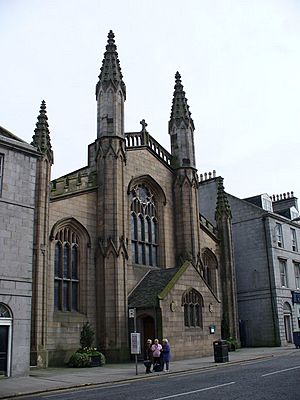
Christianity is the main religion in Aberdeen. The largest groups are the Church of Scotland and the Catholic Church. The Scottish Episcopal Church is also present.
In 2001, a census showed that Aberdeen had the highest number of people in Scotland who said they had no religion (nearly 43%). Because of this, some old churches in the city have been turned into bars or restaurants.
St Machar's Cathedral was built in the 1100s and is now a Church of Scotland church. Aberdeen also has two other cathedrals: St. Mary's Cathedral (Roman Catholic) and St. Andrew's Cathedral (Scottish Episcopal Church).
Other Christian groups like The Salvation Army and Unitarians also have churches in Aberdeen. There is also a mosque for the Islamic community, an Orthodox Jewish Synagogue, and a Thai Buddhist temple.
Aberdeen's Economy: From Granite to Oil
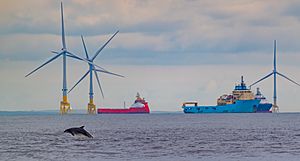
In the past, Aberdeen was known for fishing, making textiles (like cloth), shipbuilding, and paper-making. While some of these still exist, new industries have taken over. Today, Aberdeen's economy is mainly driven by high-tech electronics, research in farming and fishing, and especially the oil industry.
Paper-making used to be a big industry, starting in 1694, but most paper mills have closed. Textile production also ended in 2004.
For over 300 years, grey granite was quarried at Rubislaw quarry near Aberdeen. This granite was used for paving, buildings, and monuments. Famous places like the Houses of Parliament and Waterloo Bridge in London used Aberdeen granite! Quarrying stopped in 1971.
Fishing was once the main industry, but it has become less important as oil support vessels use the harbour. However, Aberdeen is still a significant fishing port.
Aberdeen is also well-known for its research in agriculture and soil science, with important institutes like The James Hutton Institute and the Rowett Research Institute. Many scientists who study living things work in the city.
As the amount of oil in the North Sea slowly decreases, Aberdeen is working to become the "Energy Capital of Europe." This means focusing on new energy sources like renewable energy. Aberdeen is already a world leader in technology for underwater oil drilling.
North Sea Oil and Gas: A Modern Boom
Aberdeen has been an important port for a long time. In the 1800s, it became a major centre for fishing with steam-powered trawlers.
Scientists thought there might be oil and gas under the North Sea for many years. But it was hard to get to because the waters are deep and rough. In the 1960s, exploration began, and in 1970, a large oil field called Forties was found about 110 miles (180 km) east of Aberdeen.
By 1975, the necessary structures were built, and oil started flowing through pipelines to refineries. This made Aberdeen a very important city for the oil industry.
Business and Shopping in Aberdeen
In 2011, Aberdeen was named one of the best cities in Britain for economic growth. The energy industry continues to be very strong, with new investments in the North Sea. Many large oil companies have built their global offices here.
Five of Scotland's top ten businesses are based in Aberdeen. The city also has a high employment rate.
For shopping, Aberdeen has traditional streets like Union Street and George Street. There are also modern shopping centres like the Bon Accord Centre and the Trinity Shopping Centre. A large new shopping area called Union Square opened in 2009.
Famous Places and Green Spaces
Aberdeen's buildings are famous for using granite, which is why it's called the "Granite City." Many buildings on Union Street, like the Music Hall and the National Bank of Scotland, show off this granite. The new Aberdeen Town House on Castle Street is another important granite landmark.
The extension to Marischal College on Broad Street, opened in 1906, is the second largest granite building in the world!
You'll also find many public statues in Aberdeen. Some famous ones include William Wallace and Robert Burns on Union Terrace, and Robert the Bruce holding his charter outside Marischal College.
Aberdeen is well-known for its beautiful parks and gardens. The city has won the Royal Horticultural Society's "Best City" award many times for its amazing floral displays, including millions of roses, daffodils, and crocuses.
- Duthie Park opened in 1899 and is located by the River Dee.
- Hazlehead Park is a large, forested park on the edge of the city.
- Johnston Gardens is a small, beautiful park that was named the best garden in the British Islands in 2002.
- Seaton Park is near St Machar's Cathedral and became a city park in 1947.
Aberdeen has several theatres for shows and performances:
- His Majesty's Theatre (HMT)
- The Tivoli
- Capitol Theatre
- Aberdeen Arts Centre
The main concert hall is the Music Hall, built in 1822.
Getting Around Aberdeen
Trains
Aberdeen railway station connects the city to many places. You can take direct trains to major Scottish cities like Edinburgh and Glasgow, as well as to Inverness. There are also longer journeys to cities like London and even Penzance in England.
A second station, at Dyce, serves the north of the city.
Roads
Aberdeen has six main roads connecting it to other parts of Scotland. The A90 is the most important, linking Aberdeen to Edinburgh, Dundee, and Perth in the south, and Ellon, Peterhead, and Fraserburgh in the north. A new bypass, the Aberdeen Western Peripheral Route, was finished in 2019 to help traffic flow better.
Buses and Coaches
First Aberdeen runs most of the city's bus services. Aberdeen is also the main office for FirstGroup plc, a large transport company.
Coach services connect Aberdeen to other cities in the UK, including daily services to London.
Air Travel
Aberdeen Airport (ABZ) is located in Dyce, north of the city. It has flights to places in Scotland, other parts of the UK, and some international destinations. The heliport at the airport is one of the busiest in the world, mainly serving the oil industry and rescue services.
Cycling
Aberdeen is part of the UK's National Cycle Network. There are cycle paths leading south towards Dundee and Edinburgh, and north towards Inverness and Fraserburgh. Popular paths along old railway lines include the Deeside Way and the Formartine and Buchan Way.
Water Transport
Aberdeen Harbour is the largest port in the north of Scotland. It's important for ferries to Orkney and Shetland. The harbour, which started in 1136, is sometimes called the "oldest business in Britain." It has grown from a fishing port to a major hub for the oil industry and trade with countries around the Baltic Sea and Scandinavia.
Learning in Aberdeen
Universities and Colleges

Aberdeen has two universities: the historic University of Aberdeen and the modern Robert Gordon University (RGU). About 11.5% of people in Aberdeen are students, which is higher than the average for Scotland.
The University of Aberdeen started as King's College in 1495. It is the fifth oldest university in the English-speaking world. It offers many different subjects and has about 14,000 students. The university is often ranked among the top 200 universities in the world.
Robert Gordon University began as Robert Gordon's Hospital in 1750. It became a university in 1992. RGU has grown a lot and is known for its high rate of graduates finding jobs. It was named the "Best Modern University in the UK" in 2012 by The Sunday Times.
Aberdeen also has two art schools: Gray's School of Art (founded in 1886) and Scott Sutherland School of Architecture and Built Environment. Both are now part of Robert Gordon University. North East Scotland College offers many different courses for various qualifications.
Schools in Aberdeen
Aberdeen City Council runs 15 secondary schools and 54 primary schools. There are also several private schools, such as Robert Gordon's College, Albyn School, St Margaret's School for Girls, and the International School of Aberdeen.
Some state primary schools include Airyhall Primary School and Culter Primary School. Some state secondary schools include Aberdeen Grammar School and Cults Academy.
Aberdeen's Culture and Fun
Aberdeen offers many cultural activities, places to visit, and museums. The city has won awards for its beautiful floral displays.
Galleries and Museums

The Aberdeen Art Gallery has a great collection of paintings from different time periods, as well as silver and glass. It was recently refurbished and reopened in 2019.
The Aberdeen Maritime Museum tells the story of Aberdeen's connection to the sea, from old sailing ships to modern oil and gas technology. It even has a huge model of an oil platform!
Provost Skene's House is the oldest surviving townhouse in the city, built in 1545. It reopened in 2021 with new exhibits, including a "Hall of Heroes" celebrating important Aberdonians.
The Tollbooth Museum used to be a jail and is now a public museum. The Gordon Highlanders Museum shares the history of a famous Scottish army regiment.
Festivals and Shows
Aberdeen hosts many exciting events and festivals:
- The Aberdeen International Youth Festival is one of the world's largest arts festivals for young performers.
- The Aberdeen Jazz Festival and Rootin' Aboot (a folk music event) celebrate music.
- DanceLive is Scotland's only festival for modern dance.
- The Aberdeen Student Show has been performed every year since 1921, making it the longest-running student show in the UK.
- Spectra is an annual light festival that lights up different parts of the city.
- Nuart is a festival that brings amazing street art to Aberdeen.
Local Language and Media
The local dialect of Lowland Scots spoken in Aberdeen and the North East is called Doric. It has some unique pronunciations. Every year, the Doric Festival celebrates this special language.
Aberdeen is home to Scotland's oldest newspaper, the Press and Journal, which started in 1747. There are also local radio stations like Northsound 1 and Original 106.
Music venues include the Aberdeen Music Hall and the P&J Live.
Food from Aberdeen
The Aberdeen area has given its name to some local foods, like the Aberdeen buttery (also called a "rowie") and Aberdeen Sausage.
A study in 2015 found that Aberdeen had the lowest number of fast food restaurants per person compared to other Scottish cities.
Public Services in Aberdeen
NHS Scotland provides healthcare for people in Aberdeen through the NHS Grampian health board. Aberdeen Royal Infirmary is the largest hospital in the city. There are also special hospitals for children (Royal Aberdeen Children's Hospital) and mental health (Royal Cornhill Hospital).
The Aberdeen City Council is in charge of many city services. These include schools, roads, clearing snow, maintaining parks, collecting rubbish, and street lighting. Water and sewerage services are provided by Scottish Water.
- Police: Police Scotland is responsible for policing in Aberdeen.
- Ambulance: The Scottish Ambulance Service has its North East headquarters in Aberdeen.
- Fire and Rescue: The Scottish Fire and Rescue Service handles fire and rescue in the city.
- Lifeboat: The Royal National Lifeboat Institution operates the Aberdeen Lifeboat Station to help people at sea.
Sports in Aberdeen
Football
The first recorded game of football was described by a teacher in Aberdeen in 1633!
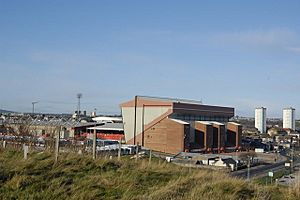
Aberdeen has two professional football clubs. Aberdeen F.C. (also known as The Dons) plays in the top Scottish league at Pittodrie Stadium. They are famous for winning the European Cup Winners Cup and the European Super Cup in 1983. Under manager Alex Ferguson, Aberdeen was a very strong team in the 1980s. The current manager is Jimmy Thelin.
The other senior team is Cove Rangers, who play at Balmoral Stadium. They have won the Highland Football League championship several times.
Rugby Union
Aberdeen is home to the Scottish Premiership Division One rugby club Aberdeen GSFP RFC. The city has also hosted international rugby games at Pittodrie Stadium.
Golf
The Royal Aberdeen Golf Club, founded in 1780, is one of the oldest golf clubs in the world. It has hosted major golf tournaments like the Senior British Open and the Walker Cup. There are also public golf courses in Aberdeen.
New golf courses are being planned, including a world-class course opened by Donald Trump just north of the city in 2012.
Other Sports
The City of Aberdeen Swim Team (COAST) trains at the Aberdeen Aquatics Centre, which has a 50-meter pool. Several swimmers from the team have competed internationally.
There are four boat clubs that row on the River Dee. Local cricket has been played in Aberdeen since 1884. The Aberdeen Lynx are an ice hockey team that plays in the Scottish National League. The Aberdeen University Shinty Club is the oldest shinty club in the world, started in 1861.
The city council also runs public tennis courts and an indoor tennis centre. The Beach Leisure Centre has a climbing wall, gym, and swimming pool. Aberdeen also has a roller derby league called Granite City Roller Derby.
Aberdeen's Twin Cities
Aberdeen is "twinned" with several cities around the world, meaning they have a special friendship and partnership:
- Stavanger, Norway (since 1990)
- Regensburg, Germany (since 1955)
- Clermont-Ferrand, France (since 1983)
- Gomel, Belarus (since 1990)
- Bulawayo, Zimbabwe (since 1986)
- Houston, Texas, US (since 1979)
- Kobe, Japan (since 2022)
- Barranquilla, Colombia
Famous People from Aberdeen
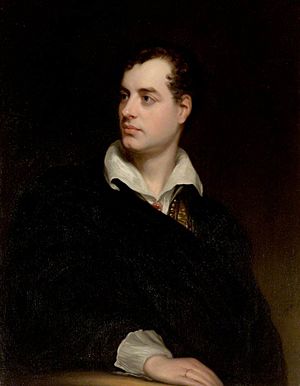
Many notable people have connections to Aberdeen:
- Lord Byron (1788–1824), a famous poet, grew up in Aberdeen.
- Denis Law, a legendary football player for Manchester United and Scotland.
- Annie Lennox, a famous musician and singer.
- Rose Leslie, an actress known for her role in Game of Thrones.
- James Clerk Maxwell (1831–1879), a brilliant scientist who studied electromagnetism, worked at Marischal College.
- Paul Lawrie, a golfer who won the 1999 Open Championship.
- Neil Fachie, a cyclist who won gold and silver medals at the 2012 Paralympic Games.
- Michael Gove, a well-known politician.
Images for kids
See also
 In Spanish: Aberdeen para niños
In Spanish: Aberdeen para niños




